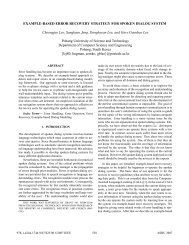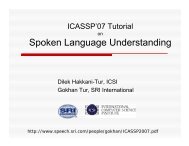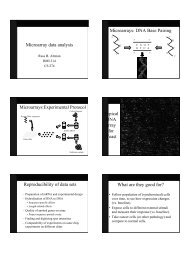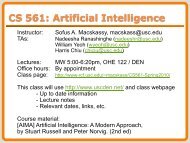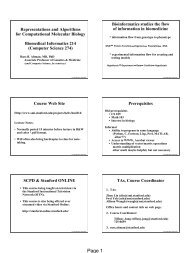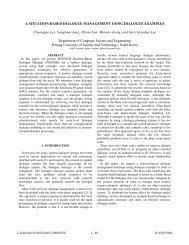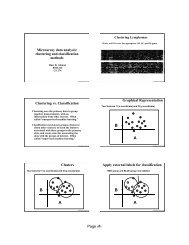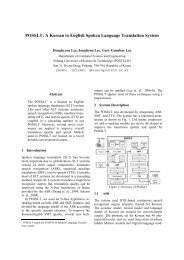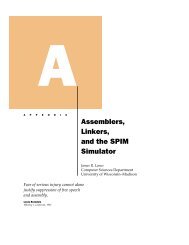Tutorial to Hidden Markov Models
Tutorial to Hidden Markov Models
Tutorial to Hidden Markov Models
You also want an ePaper? Increase the reach of your titles
YUMPU automatically turns print PDFs into web optimized ePapers that Google loves.
KISS ILVB <strong>Tu<strong>to</strong>rial</strong>(한국정보과학회<br />
한국정보과학회)| 2005.04.16 |Seoul<br />
Introduction <strong>to</strong> <strong>Hidden</strong> <strong>Markov</strong> Model<br />
and Its Application<br />
April 16, 2005<br />
Dr. Sung-Jung Cho<br />
sung-jung.cho@samsung.com<br />
Samsung Advanced Institute of Technology (SAIT)<br />
April 16, 2005, S.-J. Cho 1<br />
Contents<br />
• Introduction<br />
• <strong>Markov</strong> Model<br />
• <strong>Hidden</strong> <strong>Markov</strong> model (HMM)<br />
• Three algorithms of HMM<br />
– Model evaluation<br />
– Most probable path decoding<br />
– Model training<br />
• Pattern classification by HMM<br />
• Application of HMM <strong>to</strong> on-line handwriting recognition<br />
with HMM <strong>to</strong>olbox for Matlab<br />
• Summary<br />
• References<br />
April 16, 2005, S.-J. Cho 2
Sequential Data<br />
• Data are sequentially generated according <strong>to</strong> time or<br />
index<br />
• Spatial information along time or index<br />
April 16, 2005, S.-J. Cho 3<br />
Advantage of HMM on Sequential Data<br />
• Natural model structure: doubly s<strong>to</strong>chastic process<br />
– transition parameters model temporal variability<br />
– output distribution model spatial variability<br />
• Efficient and good modeling <strong>to</strong>ol for<br />
– sequences with temporal constraints<br />
– spatial variability along the sequence<br />
– real world complex processes<br />
• Efficient evaluation, decoding and training algorithms<br />
– Mathematically strong<br />
– Computaionally efficient<br />
• Proven technology!<br />
– Successful s<strong>to</strong>ries in many applications<br />
April 16, 2005, S.-J. Cho 4
Successful Application Areas of HMM<br />
• On-line handwriting recognition<br />
• Speech recognition<br />
• Gesture recognition<br />
• Language modeling<br />
• Motion video analysis and tracking<br />
• Protein sequence/gene sequence alignment<br />
• S<strong>to</strong>ck price prediction<br />
• …<br />
April 16, 2005, S.-J. Cho 5<br />
What’s HMM?<br />
<strong>Hidden</strong> <strong>Markov</strong> Model<br />
<strong>Hidden</strong><br />
+<br />
<strong>Markov</strong> Model<br />
What is ‘hidden’?<br />
What is ‘<strong>Markov</strong> model’?<br />
April 16, 2005, S.-J. Cho 6
<strong>Markov</strong> Model<br />
• Scenario<br />
• Graphical representation<br />
• Definition<br />
• Sequence probability<br />
• State probability<br />
April 16, 2005, S.-J. Cho 7<br />
<strong>Markov</strong> Model: Scenario<br />
• Classify a weather in<strong>to</strong> three states<br />
– State 1: rain or snow<br />
– State 2: cloudy<br />
– State 3: sunny<br />
• By carefully examining the weather of some city for a<br />
long time, we found following weather change pattern<br />
Tomorrow<br />
Rain/snow<br />
Cloudy<br />
Sunny<br />
Tod<br />
ay<br />
Rain/Snow<br />
Cloudy<br />
0.4<br />
0.2<br />
0.3<br />
0.6<br />
0.3<br />
0.2<br />
Sunny<br />
0.1<br />
0.1<br />
0.8<br />
Assumption: <strong>to</strong>morrow weather depends only on <strong>to</strong>day one!<br />
April 16, 2005, S.-J. Cho 8
<strong>Markov</strong> Model: Graphical Representation<br />
• Visual illustration with diagram<br />
0.4<br />
1:<br />
rain<br />
0.3<br />
0.2<br />
2:<br />
cloudy<br />
0.6<br />
0.3<br />
3:<br />
sunny<br />
0.2<br />
0.1 0.1<br />
0.8<br />
- Each state corresponds <strong>to</strong> one observation<br />
- Sum of outgoing edge weights is one<br />
April 16, 2005, S.-J. Cho 9<br />
<strong>Markov</strong> Model: Definition<br />
• Observable states<br />
{ 1, 2,<br />
L, N}<br />
• Observed sequence<br />
q , q2,<br />
,<br />
1<br />
L<br />
q T<br />
• 1 st order <strong>Markov</strong> assumption<br />
P( q = j | qt−<br />
= i,<br />
qt−2<br />
= k,<br />
L)<br />
= P(<br />
qt<br />
= j | qt−<br />
1<br />
L<br />
q<br />
t 1<br />
= i<br />
q1<br />
2<br />
q t−1<br />
qt<br />
0.4<br />
1:<br />
rain<br />
0.3<br />
0.3<br />
0.2<br />
3:<br />
sunny<br />
0.2<br />
0.1 0.1<br />
qt−1<br />
0.8<br />
2:<br />
cloudy<br />
qt<br />
)<br />
0.6<br />
• Stationary<br />
P( q = j | qt−<br />
= i)<br />
= P(<br />
qt+<br />
l<br />
= j | qt+<br />
l−1<br />
t 1<br />
= i<br />
Bayesian network representation<br />
April 16, 2005, S.-J. Cho 10<br />
)
<strong>Markov</strong> Model: Definition (Cont.)<br />
• State transition matrix<br />
A<br />
=<br />
⎡ a<br />
⎢<br />
⎢<br />
a<br />
⎢ M<br />
⎢<br />
⎣a<br />
– Where<br />
a<br />
ij<br />
11<br />
21<br />
N 1<br />
NN<br />
– With constraints<br />
• Initial state probability<br />
π<br />
a<br />
a<br />
a<br />
12<br />
22<br />
M<br />
L<br />
L<br />
M<br />
L<br />
a<br />
a<br />
a<br />
1N<br />
2 N<br />
M<br />
NN<br />
⎤<br />
⎥<br />
⎥<br />
⎥<br />
⎥<br />
⎦<br />
= P q = j | q<br />
−<br />
= i),<br />
1 ≤ i,<br />
(<br />
t t 1<br />
∑<br />
a ij<br />
≥ 0,<br />
a ij<br />
i<br />
N<br />
j = 1<br />
= P q = i ), 1<br />
(<br />
1<br />
≤<br />
0.4<br />
= 1<br />
i<br />
≤<br />
1:<br />
rain<br />
j<br />
N<br />
≤<br />
0.3<br />
N<br />
0.3<br />
0.2<br />
3:<br />
sunny<br />
0.2<br />
0.1 0.1<br />
0.8<br />
2:<br />
cloudy<br />
0.6<br />
April 16, 2005, S.-J. Cho 11<br />
<strong>Markov</strong> Model: Sequence Prob.<br />
• Conditional probability<br />
P ( A,<br />
B)<br />
= P(<br />
A | B)<br />
P(<br />
B)<br />
• Sequence probability of <strong>Markov</strong> model<br />
P(<br />
q<br />
1<br />
, q<br />
= P(<br />
q<br />
1<br />
= P(<br />
q<br />
1<br />
2<br />
, L,<br />
q<br />
) P(<br />
q<br />
) P(<br />
q<br />
2<br />
2<br />
T<br />
)<br />
| q<br />
| q<br />
1<br />
1<br />
) LP(<br />
q<br />
) LP(<br />
q<br />
T −1<br />
T −1<br />
Chain rule<br />
| q<br />
| q<br />
1<br />
, L,<br />
q<br />
T −2<br />
T −2<br />
) P(<br />
q<br />
T<br />
) P(<br />
q<br />
| q<br />
T<br />
T −1<br />
)<br />
| q<br />
1<br />
, L,<br />
q<br />
T −1<br />
)<br />
1 st order <strong>Markov</strong> assumption<br />
April 16, 2005, S.-J. Cho 12
<strong>Markov</strong> Model: Sequence Prob. (Cont.)<br />
• Question: What is the probability that the weather for the<br />
next 7 days will be “sun-sun-rain-rain-sun-cloudy-sun”<br />
when <strong>to</strong>day is sunny?<br />
S rain,<br />
S : cloudy,<br />
S : sunny<br />
1<br />
:<br />
2<br />
3<br />
P(<br />
O | model) = P(<br />
S<br />
3<br />
3<br />
= P(<br />
S<br />
3<br />
⋅ P(<br />
S<br />
, S<br />
1<br />
= π ⋅ a<br />
33<br />
3<br />
| S<br />
, S<br />
1<br />
3<br />
) ⋅ P(<br />
S<br />
⋅ a<br />
33<br />
= 1.536×<br />
10<br />
3<br />
−4<br />
, S<br />
1<br />
| S<br />
) P(<br />
S<br />
⋅ a<br />
, S<br />
3<br />
31<br />
3<br />
1<br />
| S<br />
, S<br />
= 1⋅(0.8)(0.8)(0.1)(0.4)(0.3)(0.1)(0.2)<br />
1<br />
11<br />
April 16, 2005, S.-J. Cho 0.8<br />
13<br />
3<br />
, S<br />
) ⋅ P(<br />
S<br />
⋅ a<br />
3<br />
13<br />
2<br />
) P(<br />
S<br />
⋅ a<br />
, S<br />
| S<br />
2<br />
⋅ a<br />
3<br />
32<br />
0.4<br />
3<br />
| S<br />
| model)<br />
) ⋅ P(<br />
S<br />
3<br />
23<br />
1:<br />
rain<br />
1<br />
) P(<br />
S<br />
⋅ a<br />
3<br />
| S<br />
3<br />
| S<br />
)<br />
2<br />
)<br />
0.3<br />
0.2<br />
0.3 0.2<br />
0.1 0.1<br />
3:<br />
sunny<br />
2:<br />
cloudy<br />
0.6<br />
<strong>Markov</strong> Model: State Probability<br />
• State probability at time t :<br />
1 2 3 ... t<br />
P( q t<br />
= i)<br />
S 1<br />
S 2<br />
...<br />
S N<br />
• Simple but slow algorithm:<br />
– Probability of a path that ends <strong>to</strong> state i at time t:<br />
Q ( i)<br />
= ( q , q , L,<br />
q = i)<br />
Exponential time complexity:<br />
t<br />
P(<br />
Q ( i))<br />
= π<br />
t<br />
1<br />
2<br />
q<br />
1<br />
t<br />
∏<br />
k = 2<br />
t<br />
P(<br />
q<br />
k<br />
| q<br />
k −1<br />
)<br />
– Summation of probabilities of all the paths that ends <strong>to</strong> I at t<br />
P(<br />
q<br />
= i)<br />
=<br />
∑<br />
P(<br />
Q ( i))<br />
O(<br />
N<br />
t<br />
t<br />
April 16, 2005, S.-J. Cho<br />
all Qt<br />
( i)'<br />
s<br />
14<br />
t<br />
)
<strong>Markov</strong> Model: State Prob. (Cont.)<br />
P( q t<br />
= i)<br />
• State probability at time t :<br />
S 1<br />
1 2 3 ... t<br />
P<br />
( q = 1) t −1 S 2<br />
...<br />
a 1 i<br />
S N<br />
• Efficient algorithm<br />
=<br />
=<br />
– Recursive path probability calculation<br />
P ( q<br />
N<br />
∑<br />
j = 1<br />
N<br />
∑<br />
t<br />
=<br />
i )<br />
P ( q<br />
P ( q<br />
=<br />
t −1<br />
N<br />
∑<br />
j = 1<br />
=<br />
=<br />
P ( q<br />
j ) ⋅ a<br />
t −1<br />
j ) P ( q<br />
t<br />
=<br />
=<br />
j , q<br />
i<br />
|<br />
q<br />
t<br />
t −1<br />
t −1<br />
ji<br />
j = 1<br />
O(<br />
April 16, 2005, S.-J. Cho 15<br />
=<br />
i )<br />
=<br />
j )<br />
Each node s<strong>to</strong>res the sum<br />
of probabilities of partial paths<br />
Time complexity: N 2 t)<br />
What’s HMM?<br />
<strong>Hidden</strong> <strong>Markov</strong> Model<br />
<strong>Hidden</strong><br />
+<br />
<strong>Markov</strong> Model<br />
What is ‘hidden’?<br />
What is ‘<strong>Markov</strong> model’?<br />
April 16, 2005, S.-J. Cho 16
<strong>Hidden</strong> <strong>Markov</strong> Model<br />
• Example<br />
• Generation process<br />
• Definition<br />
• Model evaluation algorithm<br />
• Path decoding algorithm<br />
• Training algorithm<br />
April 16, 2005, S.-J. Cho 17<br />
<strong>Hidden</strong> <strong>Markov</strong> Model: Example<br />
2<br />
0.3<br />
0.6<br />
0.2 0.6<br />
0.1 0.1<br />
0.2<br />
1 3<br />
0.3<br />
0.6<br />
• N urns containing color balls<br />
• M distinct colors<br />
• Each urn contains different number of color balls<br />
April 16, 2005, S.-J. Cho 18
HMM: Generation Process<br />
• Sequence generating algorithm<br />
– Step 1: Pick initial urn according <strong>to</strong> some random process<br />
– Step 2: Randomly pick a ball from the urn and then replace it<br />
– Step 3: Select another urn according <strong>to</strong> a random selection<br />
process<br />
2<br />
– Step 4: Repeat steps 2 and 3<br />
1 1 3<br />
0.6<br />
0.2 0.6<br />
1<br />
0.1 0.1<br />
0.2 3<br />
0.3<br />
0.3<br />
0.6<br />
<strong>Markov</strong> process: {q(t)}<br />
Output process: {f(x|q)}<br />
April 16, 2005, S.-J. Cho 19<br />
HMM: <strong>Hidden</strong> Information<br />
• Now, what is hidden?<br />
– We can just see the chosen balls<br />
– We can’t see which urn is selected at a time<br />
– So, urn selection (state transition) information is hidden<br />
April 16, 2005, S.-J. Cho 20
HMM: Definition<br />
• Notation: λ = ( Α, Β, Π )<br />
(1) N: Number of states<br />
(2) M: Number of symbols observable in states<br />
(3) A: State transition probability distribution<br />
A = { a<br />
ij<br />
}, 1 ≤ i , j ≤<br />
(4) B: Observation symbol probability distribution<br />
B<br />
V<br />
(5) Π: Initial state distribution<br />
π<br />
i<br />
=<br />
{ v 1<br />
, L , v M<br />
= P q = i ), 1<br />
(<br />
1<br />
≤<br />
N<br />
= { b ( v )}, 1 ≤ i ≤ N , 1<br />
i<br />
k<br />
}<br />
i<br />
≤<br />
N<br />
≤<br />
j<br />
≤<br />
M<br />
April 16, 2005, S.-J. Cho 21<br />
HMM: Dependency Structure<br />
• 1-st order <strong>Markov</strong> assumption of transition<br />
P( q | q , q2,<br />
L,<br />
q<br />
1)<br />
P(<br />
q | q<br />
1)<br />
t<br />
1 t− =<br />
t t−<br />
• Conditional independency of observation parameters<br />
P X | q , X , L,<br />
X , q , L,<br />
q ) =<br />
(<br />
t t 1 t−1<br />
1 t−1<br />
P(<br />
X<br />
t<br />
| qt<br />
)<br />
L<br />
q<br />
q1<br />
q2<br />
t−1<br />
qt<br />
X1<br />
X<br />
2<br />
X<br />
t−1<br />
X<br />
t<br />
Bayesian network representation<br />
April 16, 2005, S.-J. Cho 22
HMM: Example Revisited<br />
• # of states: N=3<br />
• # of observation: M=3<br />
V = { R, G, B }<br />
• Initial state distribution<br />
π = { P ( q<br />
1<br />
= i )} =<br />
• State transition probability distribution<br />
⎡0 .6 0 .2 0 .2 ⎤<br />
A = { a<br />
⎢<br />
⎥<br />
ij<br />
} =<br />
⎢<br />
0 .1 0 .3 0 .6<br />
⎥<br />
⎢⎣<br />
0 .3 0 .1 0 .6 ⎥⎦<br />
• Observation symbol probability distribution<br />
•<br />
⎡3<br />
/ 6 2 / 6 1 / 6 ⎤<br />
B = { b =<br />
⎢<br />
⎥<br />
i<br />
( v<br />
k<br />
)}<br />
⎢<br />
1 / 6 3 / 6 2 / 6<br />
⎥<br />
⎢⎣<br />
1 / 6 1 / 6 4 / 6 ⎥⎦<br />
April 16, 2005, S.-J. Cho 23<br />
0.6<br />
[1,0 ,0 ]<br />
2<br />
0.2 0.6<br />
0.1 0.1<br />
0.2<br />
1 3<br />
0.3<br />
0.3<br />
0.6<br />
HMM: Three Problems<br />
• What is the probability of generating<br />
an observation sequence?<br />
P<br />
– Model evaluation<br />
( X<br />
2<br />
= x1 , x , L , x T<br />
| λ ) =<br />
• Given observation, what is the most<br />
probable transition sequence?<br />
Q<br />
*<br />
– Segmentation or path analysis<br />
= arg max<br />
Q = ( q , , )<br />
P ( Q , X | λ )<br />
1 L qT<br />
?<br />
2 0.3<br />
0.2 0.6<br />
0.1<br />
0.6<br />
0.6<br />
1 0.1<br />
0.2 3<br />
0.3<br />
P( )?<br />
2 0.3<br />
0.2 0.6<br />
0.1<br />
0.6<br />
0.6<br />
1 0.1<br />
0.2 3<br />
0.3<br />
2 2 2 2<br />
• How do we estimate or optimize<br />
the parameters of an HMM?<br />
– Training problem<br />
P ( X | λ = ( A , B , π )) < P ( X | λ ' = ( A ' , B ' , π ' ))<br />
1 3<br />
April 16, 2005, S.-J. Cho 24<br />
2
Model Evaluation<br />
Forward algorithm<br />
Backward algorithm<br />
April 16, 2005, S.-J. Cho 25<br />
Definition<br />
• Given a model λ<br />
• Observation sequence:<br />
• P(X| λ) = ?<br />
X = x x , ,<br />
1<br />
,<br />
2<br />
L<br />
x T<br />
∑ =∑<br />
• P ( X | λ ) = P ( X , Q | λ ) P ( X | Q , λ ) P ( Q | λ )<br />
Q<br />
(A path or state sequence: Q = q , L 1<br />
, q T )<br />
Q<br />
x 1<br />
x 2<br />
x 3<br />
x 4<br />
x 5<br />
x 6<br />
x 7<br />
x 8<br />
x 1<br />
x 2<br />
x 3<br />
x 4<br />
x 5<br />
x 6<br />
x 7<br />
x 8<br />
April 16, 2005, S.-J. Cho 26
Solution<br />
• Easy but slow solution: exhaustive enumeration<br />
P ( X<br />
=<br />
∑<br />
Q<br />
| λ ) =<br />
b<br />
q<br />
∑<br />
Q<br />
P ( X , Q | λ )<br />
=<br />
( x<br />
)<br />
1 2<br />
T<br />
∑<br />
1<br />
) b<br />
q<br />
( x<br />
2<br />
) L b<br />
q<br />
( x<br />
T q<br />
a<br />
q q<br />
a<br />
q q<br />
L<br />
Q<br />
π<br />
P ( X | Q , λ ) P ( Q | λ )<br />
1<br />
1<br />
2<br />
2<br />
3<br />
a<br />
q<br />
q<br />
T −1<br />
T<br />
– Exhaustive enumeration = combinational explosion!<br />
T<br />
O ( N )<br />
• Smart solution exists?<br />
– Yes!<br />
– Dynamic Programming technique<br />
– Lattice structure based computation<br />
– Highly efficient -- linear in frame length<br />
April 16, 2005, S.-J. Cho 27<br />
Forward Algorithm<br />
• Key idea<br />
– Span a lattice of N states and T times<br />
– Keep the sum of probabilities of all the paths coming <strong>to</strong> each<br />
state i at time t<br />
x 1<br />
x 2<br />
x 3<br />
x 4<br />
x t<br />
x T<br />
S j<br />
• Forward probability<br />
α ( j)<br />
= P(<br />
x x<br />
t<br />
=<br />
=<br />
∑<br />
Q<br />
t<br />
N<br />
∑<br />
1<br />
2<br />
... x , q<br />
t<br />
t<br />
t<br />
= S<br />
P(<br />
x x ... x , Q = q ... q<br />
α<br />
1<br />
2<br />
( i)<br />
a b ( x )<br />
t−1<br />
ij j t<br />
i=<br />
1<br />
April 16, 2005, S.-J. Cho 28<br />
t<br />
j<br />
| λ)<br />
1<br />
t<br />
| λ)
Forward Algorithm<br />
• Initialization<br />
α ( i ) = π b 1 i i<br />
( x1)<br />
1 ≤ i ≤ N<br />
• Induction<br />
αt<br />
( j)<br />
= αt<br />
−<br />
• Termination<br />
N<br />
∑<br />
i=<br />
1<br />
N<br />
P X | λ)<br />
=<br />
i=<br />
1<br />
∑<br />
( i)<br />
a<br />
( α ( i )<br />
b ( x )<br />
1 ij j t<br />
T<br />
1 ≤ j ≤ N,<br />
t = 2, 3, L,<br />
T<br />
x 1<br />
x 2<br />
x 3<br />
x 4<br />
x t<br />
x T<br />
S j<br />
April 16, 2005, S.-J. Cho 29<br />
Numerical Example: P(RRGB|λ) [신봉기 03]<br />
π =[1 0 0] T .5×.6 .18<br />
R R G B<br />
.5<br />
.6<br />
.4 .1<br />
.4<br />
R<br />
G<br />
B<br />
.6<br />
.2<br />
.2<br />
.2<br />
.5<br />
.3<br />
.0<br />
.3<br />
.7<br />
1×.6<br />
0×.2<br />
0×.0<br />
.6<br />
.0<br />
.0<br />
.4×.2<br />
.6×.2 .048<br />
.1×.0<br />
.4×.0<br />
.0<br />
.5×.2 .018<br />
.4×.5<br />
.6×.5 .0504<br />
.1×.3<br />
.4×.3<br />
.01116<br />
.5×.2 .0018<br />
.4×.3<br />
.6×.3 .01123<br />
.1×.7<br />
.4×.7<br />
.01537<br />
April 16, 2005, S.-J. Cho 30
Backward Algorithm (1)<br />
• Key Idea<br />
– Span a lattice of N states and T times<br />
– Keep the sum of probabilities of all the outgoing paths at each<br />
state i at time t<br />
x 1<br />
x 2<br />
x 3<br />
x 4<br />
x t<br />
x T<br />
S j<br />
• Backward probability<br />
β ( i)<br />
= P(<br />
x x ... x | q<br />
t<br />
=<br />
=<br />
∑<br />
Q<br />
t+<br />
1<br />
N<br />
∑<br />
t+<br />
1<br />
P(<br />
x<br />
t+<br />
2<br />
t+<br />
1<br />
x<br />
a b ( x<br />
t+<br />
2<br />
T<br />
... x<br />
) β<br />
T<br />
t<br />
= S<br />
, Q<br />
( j)<br />
t+<br />
1<br />
= q<br />
ij j t+<br />
1 t+<br />
1<br />
j=<br />
1<br />
April 16, 2005, S.-J. Cho 31<br />
i<br />
, λ)<br />
t+<br />
1<br />
... q<br />
T<br />
| q<br />
t<br />
= S<br />
i<br />
, λ)<br />
Backward Algorithm (2)<br />
• Initialization<br />
β ( i)<br />
= 1<br />
T<br />
1 ≤ i ≤<br />
N<br />
• Induction<br />
N<br />
∑<br />
β ( i)<br />
= a b ( x β 1≤<br />
i ≤ N,<br />
t = T −1,<br />
T − 2, L,<br />
1<br />
t<br />
j=<br />
1<br />
ij<br />
j<br />
t+<br />
1<br />
)<br />
t+<br />
1(<br />
j)<br />
x 1<br />
x 2<br />
x 3<br />
x 4<br />
x t<br />
x T<br />
S j<br />
April 16, 2005, S.-J. Cho 32
The Most Probable Path Decoding<br />
State sequence<br />
Optimal path<br />
Viterbi algorithm<br />
Sequence segmentation<br />
April 16, 2005, S.-J. Cho 33<br />
The Most Probable Path<br />
• Given a model λ<br />
• Observation sequence: X = x<br />
• P ( X , Q | λ ) = ?<br />
• Q<br />
λ<br />
1<br />
, x<br />
2<br />
, L , x<br />
T<br />
*<br />
= arg max<br />
Q<br />
P ( X , Q | ) = arg max<br />
Q<br />
P ( X | Q , ) P ( Q | )<br />
– (A path or state sequence: Q = q , , )<br />
1 L<br />
q T<br />
λ<br />
λ<br />
x 1<br />
x 2<br />
x 3<br />
x 4<br />
x 5<br />
x 6<br />
x 7<br />
x 8<br />
x 1<br />
x 2<br />
x 3<br />
x 4<br />
x 5<br />
x 6<br />
x 7<br />
x 8<br />
April 16, 2005, S.-J. Cho 34
Viterbi Algorithm<br />
• Purpose<br />
– An analysis for internal processing result<br />
– The best, the most likely state sequence<br />
– Internal segmentation<br />
• Viterbi Algorithm<br />
– Alignment of observation and state transition<br />
– Dynamic programming technique<br />
April 16, 2005, S.-J. Cho 35<br />
Viterbi Path Idea<br />
• Key idea<br />
– Span a lattice of N states and T times<br />
– Keep the probability and the previous node of the most probable<br />
path coming <strong>to</strong> each state i at time t<br />
• Recursive path selection<br />
δ j)<br />
max δ ( i)<br />
a<br />
( = t<br />
( )<br />
+ 1 t ijb<br />
j<br />
x<br />
+ 1<br />
1≤i≤<br />
N<br />
t<br />
ψ<br />
t+ 1(<br />
j ) = arg max δ<br />
t<br />
( i)<br />
aij<br />
1≤i≤<br />
N<br />
δ<br />
t<br />
( 1) a1 jb<br />
j<br />
( x<br />
t + 1<br />
)<br />
δ ( ) (<br />
t t+1 t<br />
i a<br />
ij<br />
b<br />
j<br />
x<br />
t + 1<br />
S j<br />
– Path probability:<br />
– Path node:<br />
)<br />
April 16, 2005, S.-J. Cho 36
Viterbi Algorithm<br />
• Introduction:<br />
• Recursion:<br />
• Termination:<br />
• Path backtracking:<br />
δ ( i ) = π b 1 i i<br />
( x1)<br />
ψ1 ( i)<br />
= 0<br />
δ j)<br />
max δ ( i)<br />
a b ( x )<br />
ψ<br />
P<br />
q<br />
( = t + 1 t ij j 1<br />
1≤i≤<br />
N<br />
t+<br />
t+ 1(<br />
j ) = arg max δ<br />
t<br />
( i)<br />
aij<br />
1≤i≤<br />
N<br />
maxδ<br />
T<br />
( i)<br />
1≤i≤<br />
N<br />
arg maxδ<br />
( i)<br />
∗ =<br />
∗<br />
T<br />
=<br />
T<br />
1≤i≤<br />
N<br />
∗<br />
∗<br />
( ),<br />
t<br />
= ψ t + 1<br />
qt<br />
+ 1<br />
t = T −1,<br />
K<br />
q<br />
,1<br />
1<br />
states<br />
2<br />
3<br />
April 16, 2005, S.-J. Cho 37<br />
Numerical Example: P(RRGB,Q*|λ) [신봉기 03]<br />
π =[1 0 0] T R R G B<br />
.5<br />
.6<br />
.4 .1<br />
.4<br />
R<br />
G<br />
B<br />
.6<br />
.2<br />
.2<br />
.2<br />
.5<br />
.3<br />
.0<br />
.3<br />
.7<br />
1×.6<br />
0×.2<br />
0×.0<br />
.6<br />
.0<br />
.0<br />
.5×.6 .18<br />
.4×.2<br />
.5×.2 .018<br />
.4×.5<br />
.5×.2 .0018<br />
.4×.3<br />
.6×.2 .048<br />
.6×.5 .036<br />
.6×.3<br />
.00648<br />
.1×.0<br />
.4×.0<br />
.1×.3<br />
.4×.3<br />
.1×.7<br />
.4×.7<br />
.0<br />
.00576<br />
.01008<br />
April 16, 2005, S.-J. Cho 38
Parameter Reestimation<br />
HMM training algorithm<br />
Maximum likelihood estimation<br />
Baum-Welch reestimation<br />
April 16, 2005, S.-J. Cho 39<br />
HMM Training Algorithm<br />
• Given an observation sequence<br />
• Find the model parameter<br />
• s.t.<br />
λ<br />
*<br />
P ( X | ) ≥ P ( X | ) for ∀<br />
– Adapt HMM parameters maximally <strong>to</strong> training samples<br />
– Likelihood of a sample<br />
∑<br />
P ( X | λ ) P ( X | Q , λ ) P ( Q | λ )<br />
• NO analytical solution<br />
• Baum-Welch reestimation (EM)<br />
– iterative procedures that locally<br />
maximizes P(X|λ)<br />
– convergence proven<br />
– MLE statistic estimation<br />
Q<br />
λ<br />
= x<br />
π )<br />
1<br />
, x<br />
2<br />
, L , x<br />
T<br />
April 16, 2005, S.-J. Cho 40<br />
λ<br />
= State transition<br />
is hidden!<br />
X<br />
*<br />
λ = ( A,<br />
B ,<br />
P(X|λ)<br />
λ:HMM parameters
Maximum Likelihood Estimation<br />
• MLE “selects those parameters that maximizes the<br />
probability function of the observed sample.”<br />
• [Definition] Maximum Likelihood Estimate<br />
– Θ: a set of distribution parameters<br />
– Given X, Θ* is maximum likelihood estimate of Θ if<br />
– f(X|Θ*) = maxΘ f(X|Θ)<br />
April 16, 2005, S.-J. Cho 41<br />
MLE Example<br />
• Scenario<br />
– Known: 3 balls inside urn<br />
– (some red; some white)<br />
– Unknown: R = # red balls<br />
– Observation: (two reds)<br />
• Two models<br />
–P ( |R=2) =<br />
• Which model?<br />
–<br />
L( λR= 3<br />
) > L(<br />
λR=<br />
2)<br />
⎛ 2 ⎞⎛<br />
1 ⎞<br />
⎜<br />
2<br />
⎟<br />
⎜<br />
0<br />
⎟<br />
⎝ ⎠⎝<br />
⎠<br />
⎛ 3 ⎞<br />
–P ( |R=3) =<br />
⎜<br />
2<br />
⎟<br />
⎝ ⎠<br />
– Model(R=3) is our choice<br />
⎛ 3 ⎞<br />
⎜<br />
2<br />
⎟<br />
⎝ ⎠<br />
⎛ 3 ⎞<br />
⎜ = 1<br />
2<br />
⎟<br />
⎝ ⎠<br />
=<br />
1<br />
3<br />
April 16, 2005, S.-J. Cho 42
MLE Example (Cont.)<br />
• Model(R=3) is a more likely strategy,<br />
unless we have a priori knowledge of the system.<br />
• However, without an observation of two red balls<br />
– No reason <strong>to</strong> prefer P(λ R=3 ) <strong>to</strong> P(λ R=2 )<br />
• ML method chooses the set of parameters that<br />
maximizes the likelihood of the given observation.<br />
• It makes parameters maximally adapted <strong>to</strong> training data.<br />
April 16, 2005, S.-J. Cho 43<br />
EM Algorithm for Training<br />
( t )<br />
•With λ =< { a<br />
ij<br />
}, { bik<br />
}, π<br />
i<br />
> , estimate<br />
EXPECTATION of following quantities:<br />
–Expected number of state i visiting<br />
–Expected number of transitions from i <strong>to</strong> j<br />
•With following quantities:<br />
–Expected number of state i visiting<br />
–Expected number of transitions from i <strong>to</strong> j<br />
• Obtain the MAXIMUM LIKELIHOOD of<br />
( t + 1)<br />
λ =< { a ' }, { b ' }, π<br />
ij<br />
ik<br />
i<br />
><br />
April 16, 2005, S.-J. Cho 44
Expected Number of S i Visiting<br />
γ ( i)<br />
t<br />
= P ( q<br />
= P ( q<br />
t<br />
= S<br />
i<br />
, X | λ ) /<br />
α<br />
t<br />
( i)<br />
β<br />
t<br />
( i)<br />
=<br />
∑ α<br />
t<br />
( j)<br />
β<br />
t<br />
( j)<br />
j<br />
Γ ( i)<br />
= γ ( i)<br />
∑<br />
t<br />
t<br />
t<br />
=<br />
S<br />
i<br />
| X<br />
, λ )<br />
P ( X | λ )<br />
x 1<br />
x 2<br />
x 3<br />
x 4<br />
x t<br />
x T<br />
S i<br />
April 16, 2005, S.-J. Cho 46<br />
April 16, 2005, S.-J. Cho 45<br />
Expected Number of Transition<br />
ξ ( i,<br />
t<br />
Ξ(<br />
i,<br />
j)<br />
= P(<br />
q<br />
j)<br />
=<br />
∑<br />
t<br />
t<br />
t<br />
= S<br />
ξ ( i,<br />
i<br />
j)<br />
, q<br />
t+<br />
1<br />
= S<br />
j<br />
|<br />
X , λ)<br />
=<br />
∑∑<br />
i<br />
α ( i)<br />
a<br />
j<br />
t<br />
i<br />
ij<br />
b<br />
j<br />
α ( i)<br />
a<br />
( x<br />
ij<br />
t+<br />
1<br />
b<br />
j<br />
) β<br />
( x<br />
t+<br />
1<br />
t+<br />
1<br />
( j)<br />
) β<br />
t+<br />
1<br />
( j)<br />
x 1<br />
x 2<br />
x 3<br />
x 4<br />
x t<br />
x t+1<br />
x T<br />
S i<br />
S j
Parameter Reestimation<br />
• MLE parameter estimation<br />
a<br />
b<br />
π<br />
i<br />
ij<br />
( v<br />
i<br />
=<br />
=<br />
k<br />
T − 1<br />
)<br />
γ<br />
∑<br />
1<br />
– Iterative:<br />
t = 1<br />
T − 1<br />
∑<br />
t = 1<br />
=<br />
ξ ( i ,<br />
( i )<br />
t = 1<br />
( i )<br />
j )<br />
– convergence proven:<br />
– arriving local optima<br />
t<br />
Γ<br />
T<br />
∑<br />
t<br />
Γ<br />
P(<br />
X<br />
t<br />
( i ) δ ( x<br />
T<br />
∑<br />
t = 1<br />
t<br />
| λ<br />
Γ<br />
t<br />
t<br />
( i )<br />
) ≥<br />
, v<br />
k<br />
)<br />
P(<br />
X<br />
P(X|λ)<br />
(<br />
| λ<br />
( + 1)<br />
t)<br />
)<br />
λ:HMM parameters<br />
April 16, 2005, S.-J. Cho 47<br />
Pattern Classification by HMM<br />
• Pattern classification<br />
• Extension of HMM structure<br />
• Extension of HMM training method<br />
• Practical issues of HMM<br />
• HMM his<strong>to</strong>ry<br />
April 16, 2005, S.-J. Cho 48
Pattern Classification by HMM<br />
• Construct one HMM per each class k<br />
–<br />
λ , ,λ N<br />
1 L k<br />
• Train each HMM<br />
with samples<br />
– Baum-Welch reestimation algorithm<br />
• Calculate model likelihood of<br />
P X | λ )<br />
– Forward algorithm:<br />
with observation X<br />
• Find the model with maximum a posteriori probability<br />
*<br />
λ = argmax<br />
= argmax<br />
= argmax<br />
λ k<br />
λ k<br />
λ k<br />
λ<br />
(<br />
k<br />
P(<br />
λ | X )<br />
P(<br />
λ ) P(<br />
X<br />
k<br />
P(<br />
λ ) P(<br />
X<br />
k<br />
k<br />
| λ ) / P(<br />
X )<br />
k<br />
| λ )<br />
k<br />
D k<br />
λ , L 1<br />
,λ N<br />
April 16, 2005, S.-J. Cho 49<br />
Extension of HMM Structure<br />
• Extension of state transition parameters<br />
– Duration modeling HMM<br />
• More accurate temporal behavior<br />
– Transition-output HMM<br />
• HMM output functions are attached <strong>to</strong> transitions rather than states<br />
• Extension of observation parameter<br />
– Segmental HMM<br />
• More accurate modeling of trajec<strong>to</strong>ries at each state, but more<br />
computational cost<br />
– Continuous density HMM (CHMM)<br />
• Output distribution is modeled with mixture of Gaussian<br />
– Semi-continuous HMM<br />
• Mix of continuous HMM and discrete HMM by sharing Gaussian<br />
components<br />
April 16, 2005, S.-J. Cho 50
Extension of HMM Training Method<br />
• Maximum Likelihood Estimation (MLE)*<br />
– maximize the probability of the observed samples<br />
• Maximum Mutual Information (MMI) Method<br />
– information-theoretic measure<br />
– maximize average mutual information:<br />
V<br />
V<br />
*<br />
⎧ ⎡<br />
v<br />
w ⎤ ⎫<br />
I = max<br />
λ ⎨∑ ⎢log<br />
P ( X | λ<br />
v<br />
) − log ∑ P ( X | λ<br />
w<br />
) ⎥ ⎬<br />
⎩ ν = 1 ⎣<br />
w = 1<br />
⎦ ⎭<br />
– maximize discrimination power by training models <strong>to</strong>gether<br />
• Minimal Discriminant Information (MDI) Method<br />
– minimize the DI or the cross entropy between pd(signal) and<br />
pd(HMM)’s<br />
– use generalized Baum algorithm<br />
April 16, 2005, S.-J. Cho 51<br />
Practical Issues of HMM<br />
• Architectural and behavioral choices<br />
– the unit of modeling -- design choice<br />
– type of models: ergodic, left-right, etc.<br />
– number of states<br />
– observation symbols;discrete, continuous; mixture number<br />
• Initial estimates<br />
π<br />
– A, : adequate with random or uniform initial values<br />
– B : good initial estimates are essential for CHMM<br />
April 16, 2005, S.-J. Cho 52
Practical Issues of HMM (Cont.)<br />
• Scaling<br />
α ( i)<br />
=<br />
t<br />
t−1<br />
∏<br />
s=<br />
1<br />
t<br />
s, s+<br />
1∏bs<br />
( xs<br />
)<br />
s=<br />
1<br />
– heads exponentially <strong>to</strong> zero: --> scale by 1 / Si=1,…,N at(i)<br />
• Multiple observation sequences<br />
– accumulate the expected freq. with weight P(X(k)|l)<br />
• Insufficient training data<br />
a<br />
– deleted interpolation with desired model & small model<br />
– output prob. smoothing (by local perturbation of symbols)<br />
– output probability tying between different states<br />
April 16, 2005, S.-J. Cho 53<br />
HMM His<strong>to</strong>ry [Roweis]<br />
• <strong>Markov</strong>(’13) and Shannon (’48, ’51) studied <strong>Markov</strong><br />
chains<br />
• Baum et. Al (BP’66, BE’67 …) developed many theories<br />
of “probabilistic functions of <strong>Markov</strong> chains”<br />
• Viterbi (’67) developed an efficient optimal state search<br />
algorithm<br />
• Application <strong>to</strong> speech recognition started<br />
– Baker(’75) at CMU<br />
– Jelinek’s group (’75) at IBM<br />
• Dempster, Laird & Rubin ('77) recognized a general form<br />
of the Baum-Welch algorithm<br />
April 16, 2005, S.-J. Cho 54
Application of HMM <strong>to</strong> on-line<br />
handwriting recognition with HMM SW<br />
• SW <strong>to</strong>ols for HMM<br />
• Introduction <strong>to</strong> on-line handwriting<br />
recognition<br />
• Data preparation<br />
• Training & testing<br />
April 16, 2005, S.-J. Cho 55<br />
SW Tools for HMM<br />
• HMM <strong>to</strong>olbox for Matlab<br />
– Developed by Kevin Murphy<br />
– Freely downloadable SW written in Matlab (Hmm… Matlab is not free!)<br />
– Easy-<strong>to</strong>-use: flexible data structure and fast pro<strong>to</strong>typing by Matlab<br />
– Somewhat slow performance due <strong>to</strong> Matlab<br />
– Download: http://www.cs.ubc.ca/~murphyk/Software/HMM/hmm.html<br />
• HTK (<strong>Hidden</strong> <strong>Markov</strong> <strong>to</strong>olkit)<br />
– Developed by Speech Vision and Robotics Group of Cambridge<br />
University<br />
– Freely downloadable SW written in C<br />
– Useful for speech recognition research: comprehensive set of programs<br />
for training, recognizing and analyzing speech signals<br />
– Powerful and comprehensive, but somewhat complicate and heavy<br />
package<br />
– Download: http://htk.eng.cam.ac.uk/<br />
April 16, 2005, S.-J. Cho 56
SW Tools: HMM Toolbox for Matlab<br />
• Support training and decoding for<br />
– Discrete HMMs<br />
– Continuous HMMs with full, diagonal, or spherical covariance<br />
matrix<br />
• 3 Algorithms for discrete HMM<br />
– Model evaluation (Forward algorithm)<br />
• Log_likelihood = dhmm_logprob(data, initial state probability, transition<br />
probability matrix, observation probability matrix)<br />
– Viterbi decoding algorithm<br />
• 1) B = multinomial_prob(data, observation matrix);<br />
B(i,t) = P(y_t | Q_t=i) for all t,i:<br />
• 2) [path, log_likelihood] = viterbi_path(initial state probability, transition<br />
matrix, B)<br />
– Baum-Welch algorithm<br />
• [LL, prior2, transmat2, obsmat2] = dhmm_em(data, prior1, transmat1,<br />
obsmat1, 'max_iter', 5);<br />
April 16, 2005, S.-J. Cho 57<br />
On-line Handwriting Recognition [Sin]<br />
• Handwriting<br />
– Natural input method <strong>to</strong> human<br />
– Sequence of some writing units<br />
– Temporally ordered<br />
• Time series of (X,Y) ink points on tablet<br />
• Recognition flow<br />
Input<br />
Pre-processing<br />
Input Feature<br />
Encoding<br />
Result<br />
Post-processing<br />
Classification<br />
Dictionary<br />
Model<br />
April 16, 2005, S.-J. Cho 58
Data Preparation<br />
12 15<br />
11<br />
10<br />
9<br />
8<br />
7<br />
6<br />
5<br />
14<br />
15<br />
16<br />
1<br />
2<br />
3<br />
4<br />
• Chaincode data set for class ‘0’<br />
– data0{1} = [9 8 8 7 7 7 6 6 6 5 5 5 4 4 3 2 1 16 15 15 15 15 14 14 14 13<br />
13 13 12 12 11 10 9 9 8 ]<br />
– data0{2} = [8 8 7 7 7 6 6 5 5 5 5 4 4 3 2 1 1 16 15 15 15 15 15 14 14 14<br />
14 13 12 11 10 10 9 9 9 ]<br />
– data0{3} = [7 6 6 6 6 6 6 5 5 5 4 3 2 1 16 16 16 15 15 15 15 14 14 14 14<br />
14 14 13 11 10 9 9 8 8 8 8 7 7 6 6 ]<br />
• Chaincode data set for class ‘1’<br />
– data1{1} = [5 5 5 5 5 5 5 5 5 5 5 4 ]<br />
– data1{2} = [5 6 6 6 6 6 6 6 6 5 5 4 ]<br />
– data1{3} = [5 5 5 6 6 6 6 6 6 7 6 4 3]<br />
April 16, 2005, S.-J. Cho 59<br />
HMM Initialization<br />
• HMM for class ‘0’ and randomly initialization<br />
– hmm0.prior = [1 0 0];<br />
– hmm0.transmat = rand(3,3); % 3 by 3 transition matrix<br />
– hmm0.transmat(2,1) =0; hmm0.transmat(3,1) = 0; hmm0.transmat(3,2) = 0;<br />
– hmm0.transmat = mk_s<strong>to</strong>chastic(hmm0.transmat);<br />
– hmm0.transmat<br />
0.20 0.47 0.33<br />
0 0.45 0.55<br />
0 0.00 1.00<br />
– hmm0.obsmat = rand(3, 16); % # of states * # of observation<br />
– hmm0.obsmat = mk_s<strong>to</strong>chastic(hmm0.obsmat)<br />
1 2 3<br />
0.02 0.04 0.05 0.00 0.12 0.11 0.13 0.00 0.06 0.09 0.02 0.11 0.06 0.05 0.04 0.08<br />
0.12 0.04 0.07 0.06 0.03 0.03 0.08 0.02 0.11 0.04 0.02 0.06 0.06 0.11 0.01 0.12<br />
0.05 0.04 0.01 0.11 0.02 0.08 0.11 0.10 0.09 0.02 0.05 0.10 0.06 0.00 0.09 0.07<br />
April 16, 2005, S.-J. Cho 60
HMM Initialization (Cont.)<br />
• HMM for class ‘1’ and randomly initialization<br />
– hmm1.prior = [1 0];<br />
– hmm1.transmat = rand(2,2); % 2 by 2 transition matrix<br />
– hmm1.transmat(2,1) =0;<br />
– hmm1.transmat = mk_s<strong>to</strong>chastic(hmm1.transmat);<br />
– hmm1.transmat<br />
0.03 0.97<br />
0 1.00<br />
– hmm1.obsmat = rand(2, 16); % # of states * # of observation<br />
– hmm1.obsmat = mk_s<strong>to</strong>chastic(hmm1.obsmat)<br />
1 2<br />
0.05 0.10 0.01 0.06 0.02 0.09 0.06 0.02 0.10 0.04 0.12 0.11 0.03 0.01 0.09 0.11<br />
0.08 0.09 0.06 0.05 0.09 0.10 0.07 0.06 0.12 0.03 0.03 0.12 0.03 0.01 0.03 0.02<br />
April 16, 2005, S.-J. Cho 61<br />
HMM Training<br />
• Training of model 0<br />
– [LL0, hmm0.prior, hmm0.transmat, hmm0.obsmat] = dhmm_em(data0,<br />
hmm0.prior, hmm0.transmat, hmm0.obsmat)<br />
iteration 1, loglik = -365.390770<br />
iteration 2, loglik = -251.112160<br />
0.91 0.93 1<br />
…<br />
0.09 0.07<br />
iteration 9, loglik = -210.991114<br />
1 2 3<br />
• Trained result<br />
- hmm0.transmat<br />
0.91 0.09 0.00<br />
0.00 0.93 0.07<br />
0.00 0.00 1.00<br />
- hmm0.obsmat<br />
0<br />
0.00 0.00 0.00 0.00 0.30 0.33 0.21 0.12 0.03 0.00 0.00 0.00 0.00 0.00 0.00 0.00<br />
0.09 0.07 0.07 0.11 0.00 0.00 0.00 0.00 0.00 0.00 0.00 0.00 0.00 0.28 0.28 0.11<br />
0.00 0.00 0.00 0.00 0.00 0.06 0.06 0.16 0.23 0.13 0.10 0.10 0.16 0.00 0.00 0.00<br />
April 16, 2005, S.-J. Cho 62
HMM Training (Cont.)<br />
• Training of model 1<br />
– [LL1, hmm1.prior, hmm1.transmat, hmm1.obsmat] = dhmm_em(data1,<br />
hmm1.prior, hmm1.transmat, hmm1.obsmat)<br />
• iteration 1, loglik = -95.022843<br />
• …<br />
• iteration 10, loglik = -30.742533<br />
• Trained model<br />
– hmm1.transmat<br />
0.79 0.21<br />
0.00 1.00<br />
– hmm1.obsmat<br />
0.79 1<br />
0.21<br />
1 2<br />
0.00 0.00 0.00 0.00 1.00 0.00 0.00 0.00 0.00 0.00 0.00 0.00 0.00 0.00 0.00 0.00<br />
0.00 0.00 0.04 0.13 0.12 0.66 0.04 0.00 0.00 0.00 0.00 0.00 0.00 0.00 0.00 0.00<br />
April 16, 2005, S.-J. Cho 63<br />
HMM Evaluation<br />
• Evaluation of data 0<br />
– for dt =1:length(data0)<br />
– loglike0 = dhmm_logprob(data0{dt}, hmm0.prior, hmm0.transmat,<br />
hmm0.obsmat);<br />
– loglike1 = dhmm_logprob(data0{dt}, hmm1.prior, hmm1.transmat,<br />
hmm1.obsmat);<br />
– disp(sprintf('[class 0: %d-th data] model 0: %.3f, model 1: %.3f',dt,<br />
loglike0, loglike1));<br />
– end<br />
[class 0: 1-th data] model 0: -68.969, model 1: -289.652<br />
[class 0: 2-th data] model 0: -66.370, model 1: -291.671<br />
[class 0: 3-th data] model 0: -75.649, model 1: -310.484<br />
• Evaluation of data 1<br />
[class 0: 1-th data] model 0: -18.676, model 1: -5.775<br />
[class 0: 2-th data] model 0: -17.914, model 1: -11.162<br />
[class 0: 3-th data] model 0: -21.193, model 1: -13.037<br />
April 16, 2005, S.-J. Cho 64
HMM Decoding<br />
• For data ‘0’, get the most probable path<br />
– for dt =1:length(data0)<br />
– B = multinomial_prob(data0{dt}, hmm0.obsmat);<br />
– path = viterbi_path(hmm0.prior, hmm0.transmat, B);<br />
– disp(sprintf('%d', path));<br />
– end<br />
11111111111122222222222223333333333<br />
11111111111222222222222222233333333<br />
1111111111222222222222222223333333333333<br />
• For data ‘1’, get the most probable path<br />
111111111112<br />
122222222222<br />
1112222222222<br />
April 16, 2005, S.-J. Cho 65<br />
Summary<br />
• <strong>Markov</strong> model<br />
– 1-st order <strong>Markov</strong> assumption on state transition<br />
– ‘Visible’: observation sequence determines state transition seq.<br />
• <strong>Hidden</strong> <strong>Markov</strong> model<br />
– 1-st order <strong>Markov</strong> assumption on state transition<br />
– ‘<strong>Hidden</strong>’: observation sequence may result from many possible<br />
state transition sequences<br />
– Fit very well <strong>to</strong> the modeling of spatial-temporally variable signal<br />
– Three algorithms: model evaluation, the most probable path<br />
decoding, model training<br />
• Example of HMM application <strong>to</strong> on-line handwriting<br />
recognition<br />
– Use HMM <strong>to</strong>ol box for Matlab<br />
April 16, 2005, S.-J. Cho 66
References<br />
• <strong>Hidden</strong> <strong>Markov</strong> Model<br />
– L.R. Rabiner, “A <strong>Tu<strong>to</strong>rial</strong> <strong>to</strong> <strong>Hidden</strong> <strong>Markov</strong> <strong>Models</strong> and Selected<br />
Applications in Speech Recognition”, IEEE Proc. pp. 267-295,<br />
1989<br />
– L.R. Bahl et. al, “A Maximum Likelihood Approach <strong>to</strong> Continuous<br />
Speech Recognition”, IEEE PAMI, pp. 179-190, May. 1983<br />
– M. Ostendorf, “From HMM’s <strong>to</strong> Segment <strong>Models</strong>: a Unified View<br />
of S<strong>to</strong>chastic Modeling for Speech Recognition”, IEEE SPA, pp<br />
360-378, Sep., 1996<br />
• HMM <strong>Tu<strong>to</strong>rial</strong>s<br />
– 신봉기, “HMM Theory and Applications “, 2003컴퓨터비젼및패턴<br />
인식연구회 춘계워크샵 튜토리얼<br />
– Sam Roweis, “<strong>Hidden</strong> <strong>Markov</strong> <strong>Models</strong> (SCIA <strong>Tu<strong>to</strong>rial</strong> 2003)”,<br />
http://www.cs.<strong>to</strong>ron<strong>to</strong>.edu/~roweis/notes/scia03h.pdf<br />
– Andrew Moore, “<strong>Hidden</strong> <strong>Markov</strong> <strong>Models</strong>”,<br />
http://www-2.cs.cmu.edu/~awm/tu<strong>to</strong>rials/hmm.html<br />
April 16, 2005, S.-J. Cho 67<br />
References (Cont.)<br />
• HMM SW<br />
– Kevin Murphy, “HMM <strong>to</strong>olbox for Matlab”, freely downloadable SW<br />
written in Matlab,<br />
http://www.cs.ubc.ca/~murphyk/Software/HMM/hmm.html<br />
– Speech Vision and Robotics Group of Cambridge University, “HTK<br />
(<strong>Hidden</strong> <strong>Markov</strong> <strong>to</strong>olkit)”, freely downloadable SW written in C,<br />
http://htk.eng.cam.ac.uk/<br />
• Online Character Recognition<br />
– C.C. Tappert et. al, “The state of the Art in On-Line Handwriting<br />
Recognition”, IEEE PAMI, pp. 787-808, Aug, 1990<br />
– B.K. Sin and J.H. Kim, “Ligature Modeling for Online Cursive Script<br />
Recognition”, IEEE PAMI, pp. 623-633,Jun, 1997<br />
– S.-J. Cho and J.H. Kim, “Bayesian Network Modeling of Character<br />
Components and Their Relationships for On-line Handwriting<br />
Recognition”, Pattern Recognition, pp253-264, Feb. 2004<br />
– J. Hu, et. al, “Writer Independent On-line Handwriting Recognition Using<br />
an HMM Approach”, Pattern Recognition, pp 133-147, 2000<br />
April 16, 2005, S.-J. Cho 68
Appendix: Matlab Code (I)<br />
% chaincode data set for class '0'<br />
data0{1} = [9 8 8 7 7 7 6 6 6 5 5 5 4 4 3 2 1 16 15 15 15 15 14 14 14 13 13 13 12 12 11<br />
10 9 9 8 ];<br />
data0{2} = [8 8 7 7 7 6 6 5 5 5 5 4 4 3 2 1 1 16 15 15 15 15 15 14 14 14 14 13 12 11 10<br />
10 9 9 9 ];<br />
data0{3} = [7 6 6 6 6 6 6 5 5 5 4 3 2 1 16 16 16 15 15 15 15 14 14 14 14 14 14 13 11 10<br />
9 9 8 8 8 8 7 7 6 6 ];<br />
% chaincode data set for class ‘1’<br />
data1{1} = [5 5 5 5 5 5 5 5 5 5 5 4 ];<br />
data1{2} = [5 6 6 6 6 6 6 6 6 5 5 4 ];<br />
data1{3} = [5 5 5 6 6 6 6 6 6 7 6 4 3];<br />
% HMM for class '0' and random initialization of parameters<br />
hmm0.prior = [1 0 0];<br />
hmm0.transmat = rand(3,3); % 3 by 3 transition matrix<br />
hmm0.transmat(2,1) =0; hmm0.transmat(3,1) = 0; hmm0.transmat(3,2) = 0;<br />
hmm0.transmat = mk_s<strong>to</strong>chastic(hmm0.transmat);<br />
hmm0.transmat<br />
hmm0.obsmat = rand(3, 16); % # of states * # of observation<br />
hmm0.obsmat = mk_s<strong>to</strong>chastic(hmm0.obsmat)<br />
April 16, 2005, S.-J. Cho 69<br />
Appendix: Matlab Code (2)<br />
% HMM for class '1' and random initialiation of parameters<br />
hmm1.prior = [1 0 ];<br />
hmm1.transmat = rand(2,2); % 2 by 2 transition matrix<br />
hmm1.transmat(2,1) =0;<br />
hmm1.transmat = mk_s<strong>to</strong>chastic(hmm1.transmat);<br />
hmm1.transmat<br />
hmm1.obsmat = rand(2, 16); % # of states * # of observation<br />
hmm1.obsmat = mk_s<strong>to</strong>chastic(hmm1.obsmat)<br />
% Training of HMM model 0 (Baum-Welch algorithm)<br />
[LL0, hmm0.prior, hmm0.transmat, hmm0.obsmat] = dhmm_em(data0, hmm0.prior,<br />
hmm0.transmat, hmm0.obsmat)<br />
% smoothing of HMM observation parameter: set floor value 1.0e-5<br />
hmm0.obsmat = max(hmm0.obsmat, 1.0e-5);<br />
% Training of HMM model 1 (Baum-Welch algorithm)<br />
[LL1, hmm1.prior, hmm1.transmat, hmm1.obsmat] = dhmm_em(data1, hmm1.prior,<br />
hmm1.transmat, hmm1.obsmat)<br />
% smoothing of HMM observation parameter: set floor value 1.0e-5<br />
hmm1.obsmat = max(hmm1.obsmat, 1.0e-5);<br />
April 16, 2005, S.-J. Cho 70
Appendix: Matlab Code(3)<br />
% Compare model likelihood<br />
%Evaluation of class '0' data<br />
for dt =1:length(data0)<br />
end<br />
loglike0 = dhmm_logprob(data0{dt}, hmm0.prior, hmm0.transmat, hmm0.obsmat);<br />
loglike1 = dhmm_logprob(data0{dt}, hmm1.prior, hmm1.transmat, hmm1.obsmat);<br />
disp(sprintf('[class 0: %d-th data] model 0: %.3f, model 1: %.3f',dt, loglike0, loglike1));<br />
for dt =1:length(data1)<br />
end<br />
loglike0 = dhmm_logprob(data1{dt}, hmm0.prior, hmm0.transmat, hmm0.obsmat);<br />
loglike1 = dhmm_logprob(data1{dt}, hmm1.prior, hmm1.transmat, hmm1.obsmat);<br />
disp(sprintf('[class 1: %d-th data] model 0: %.3f, model 1: %.3f',dt, loglike0, loglike1));<br />
April 16, 2005, S.-J. Cho 71<br />
Appendix: Matlab Code (4)<br />
%Viterbi path decoding<br />
%First you need <strong>to</strong> evaluate B(i,t) = P(y_t | Q_t=i) for all t,i:<br />
path0 = cell(1, length(data0));<br />
for dt =1:length(data0)<br />
B = multinomial_prob(data0{dt}, hmm0.obsmat);<br />
end<br />
path0{dt} = viterbi_path(hmm0.prior, hmm0.transmat, B);<br />
disp(sprintf('%d', path0{dt}));<br />
path1 = cell(1, length(data1));<br />
for dt =1:length(data1)<br />
B = multinomial_prob(data1{dt}, hmm1.obsmat);<br />
end<br />
path1{dt} = viterbi_path(hmm1.prior, hmm1.transmat, B);<br />
disp(sprintf('%d', path1{dt}));<br />
April 16, 2005, S.-J. Cho 72



